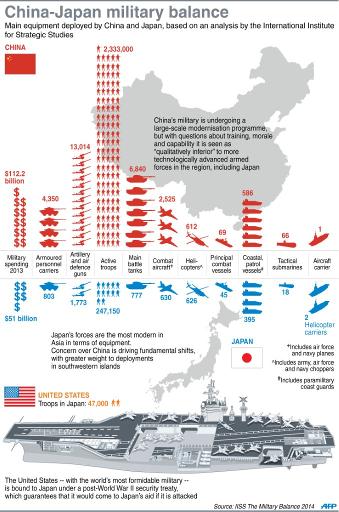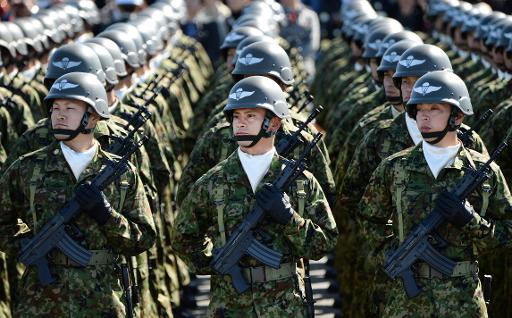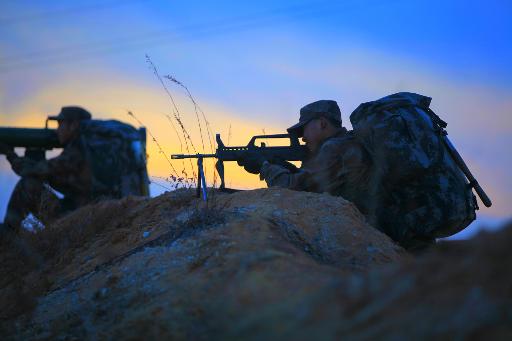Beijing (AFP) - With the world's biggest military, China far outnumbers rival Japan in manpower, ships, aircraft and defence spending, but analysts say underlying weaknesses leave it still wary of a fight.
The two Asian powers are embroiled in simmering territorial and historical rows, with the tensions highlighted this week in consecutive visits to each by US Defense Secretary Chuck Hagel.
Beijing's latest double-digit rise in its defence budget, announced last month, will only increase its numerical superiority, but Japan enjoys technological and training advantages, and the key asset of a US security umbrella.
Hagel reiterated Washington's support for Tokyo while criticising Beijing in blunt exchanges with top People's Liberation Army (PLA) generals.
China, for its part, told the Vietnam War veteran that sovereignty over islands in the East China Sea at the heart of the dispute with Japan was non-negotiable and that it would "make no compromise".
Despite such tough talk, analysts say China's top strategists know an armed conflict, intentional or accidental, is not in their interest and could detract from their long-term goal of expanding their regional and global power.
"The Chinese high command has got to be very prudent and cautious in terms of the launch of any kind of military operation," said Arthur Ding, an expert on the PLA at Taiwan's National Chengchi University.

Even without the benefit of the US security alliance, Japan currently has better training, facilities and equipment, Ding said, although the long term situation was less clear.
"Right now Japan is in better shape," he told AFP.
Even Chinese President Xi Jinping has urged the military -- which is beset by corruption, with high-ranking officers under investigation -- to improve its abilities to "win battles".
- Huge leads -
The dispute over the uninhabited islands, administered by Japan as the Senkakus and claimed by China as the Diaoyus, has heated up since Tokyo bought islands in the chain from private Japanese owners in 2012.
Ships and aircraft from both countries, mostly dispatched by non-military maritime and coastguard agencies, regularly patrol the area.
In a tense incident early last year, however, Japan accused a Chinese frigate of directing its weapon-targeting radar at one of Tokyo's naval vessels, fuelling worries about a clash.

China's first aircraft carrier, the Liaoning, went into service 18 months ago and according to the International Institute for Strategic Studies' Military Balance 2014 report, published in February, the country's forces outnumber Japan in virtually all areas.
China had approximately 2.3 million active duty troops last year compared with Japan's 247,150, the report said. China also enjoyed huge leads in combat aircraft at 2,525 to 630, main battle tanks at 6,840 to 777 and tactical submarines at 66 to 18.
China's defence budget was $112.2 billion last year, while Japan's came to $51 billion, according to the report.
"The PLA is engaged in a modernisation programme fuelled by the country’s rapid economic development that has seen it surpass the armed forces of less developed countries in Asia," the report said.
It added, however, that China had shortfalls including a lack of combat experience, questions about training and morale, and weaknesses in command and control, anti-submarine warfare and other areas.
China's military "remains qualitatively inferior, in some respects, to more technologically advanced armed forces in the region -- such as South Korea and Japan -- and it lags far behind the US", the report said.
Art of war
Tokyo and Washington, once bitter wartime enemies, have had a close defence relationship since Japan's World War II defeat in 1945, with the US obligated to defend its ally if it is attacked.
The US military has nearly 50,000 troops stationed in Japan at key strategic bases including on the southern island of Okinawa, a short flight to the disputed islands.

Kazuhisa Ogawa, a respected Japanese military affairs analyst, said that Japan's capabilities cannot be looked at as separate from those of the US.
"The Japanese military is not designed to stand on its own," Ogawa said, referring to its Self-Defense Forces.
"Japan is facing the Chinese military together with the US force, so it is nonsense to compare the capabilities of the Japanese military and the Chinese military without the presence of the US," he told AFP
Though the Chinese Communist Party and state media regularly chastise Japan over the territorial dispute and accuse it of nascent militarism and denial of wartime atrocities in China, pronouncements by top officials can be more prudent.
In his exchanges with Hagel, China's defence chief Chang Wanquan suggested the country would not take pre-emptive action in the island dispute.
But Ogawa said Beijing had a clear strategy despite its reluctance to start an armed conflict.
"China is sending non-military ships to the area," he said, to assert its claim, gauge the reactions of Japan and the US, and show nationalistic elements at home it is flexing its muscles.
"China's policy is to win without a battle, taking the path of Sun Tzu's 'Art of War'." - AFP
Get 30% off with our ads free Premium Plan!

china , japan , art of war , military , army
Found a mistake in this article?
Report it to us.
Thank you for your report!





